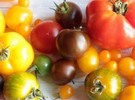In the vegetable aisle, c onsumers can choose from a wide range of tomato varieties. Red tomatoes, which are not too expensive, usually end up in the shopping basket. This is the result of a study by the University of Göttingen.
onsumers can choose from a wide range of tomato varieties. Red tomatoes, which are not too expensive, usually end up in the shopping basket. This is the result of a study by the University of Göttingen.
The scientists had asked over 1,000 consumers in Germany about their preferences when buying tomatoes. The focus was on the characteristics of colour, size, internal firmness, taste, skin, aroma, regionality, label and price. In an experiment, shopping in the supermarket was simulated online: The subjects were asked to choose a particular tomato variety based on descriptions of features and photos. All the vegetables came from Germany. A simple traffic light marking (red, yellow, green) on the label showed the climate friendliness of the product.
Purchasing behaviour and the choice of food are influenced by many different factors. These include previous experience, personal preferences, lifestyle and available information about the product. Tomatoes are the most consumed vegetables in Germany. Consumers will find numerous tomato varieties on the market - from round tomatoes to egg and cherry tomatoes, ribbed, plum and pear-shaped tomatoes. The colour palette ranges from red to yellow to green. But which one ends up in the shopping basket?
Climate-critical aspects
The evaluation of the results showed that German consumers primarily choose fresh tomatoes according to price (32%), colour (22%) and taste (16%). Even though the variety of colours has increased in recent years, red is still in first place. Green tomato varieties are avoided. Many consumers probably mistakenly think that these special varieties are not yet ripe. Aroma and size (6 % each), regionality and internal firmness (4 % each) are less important for the purchase decision.
From the consumer's point of view, plastic packaging and air freight are the most climate-damaging aspects of tomato production. However, air transport plays hardly any role for tomatoes. The energy consumption of heated greenhouses, on the other hand, is often underestimated, the authors explain in the British Food Journal. In further studies, the test persons are actually supposed to shop in a supermarket. Then the vegetables can be judged with all the senses before they are bought.
Source: BZFE / University of Göttingen
